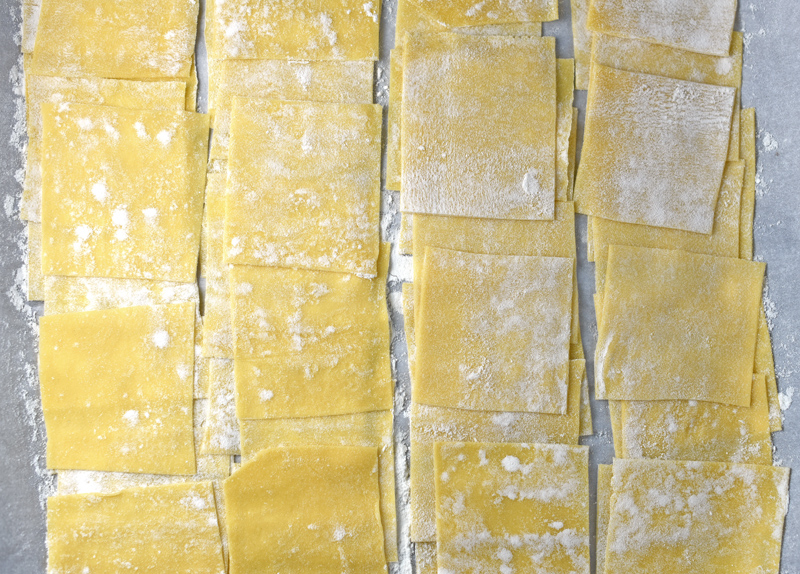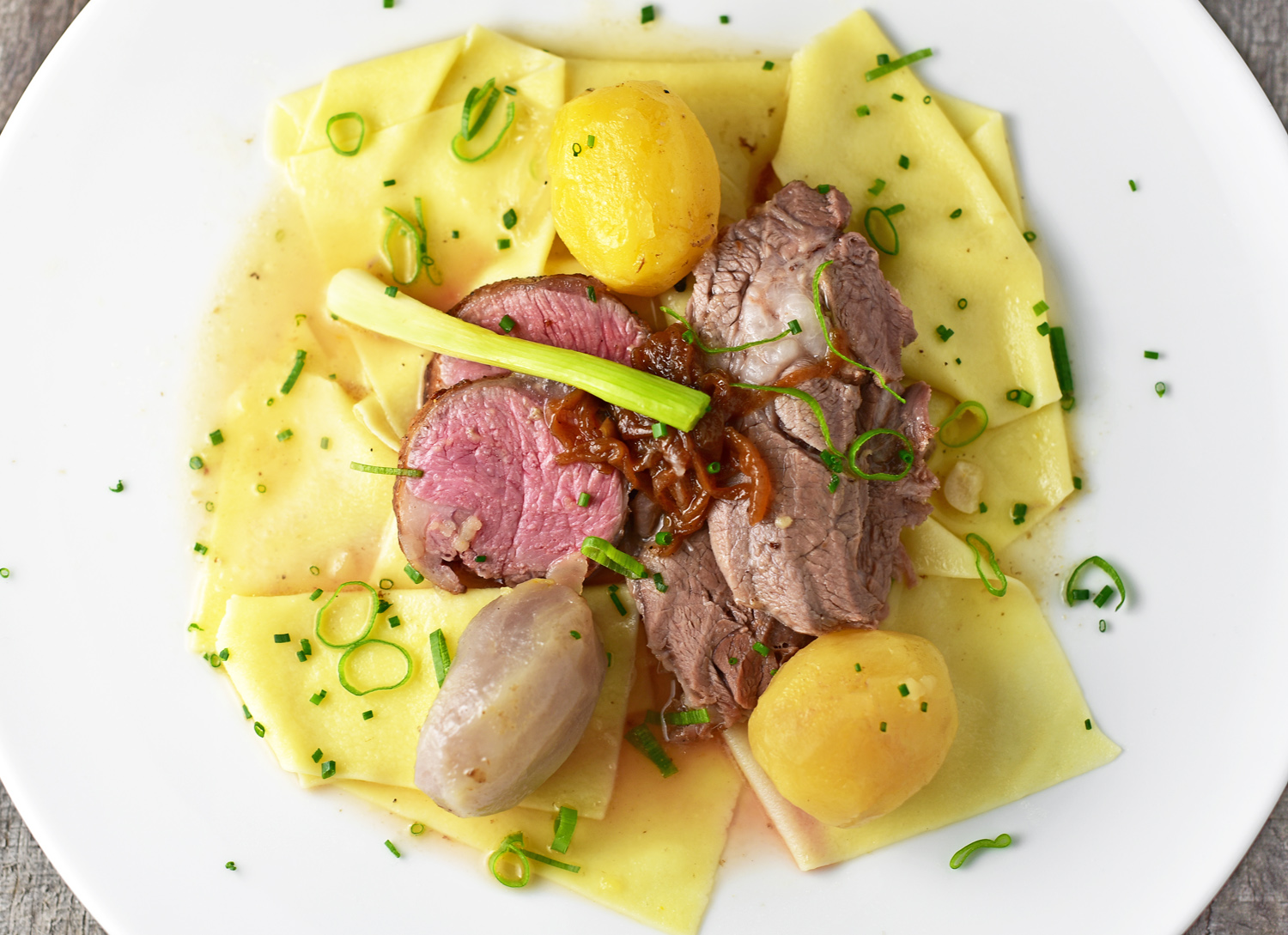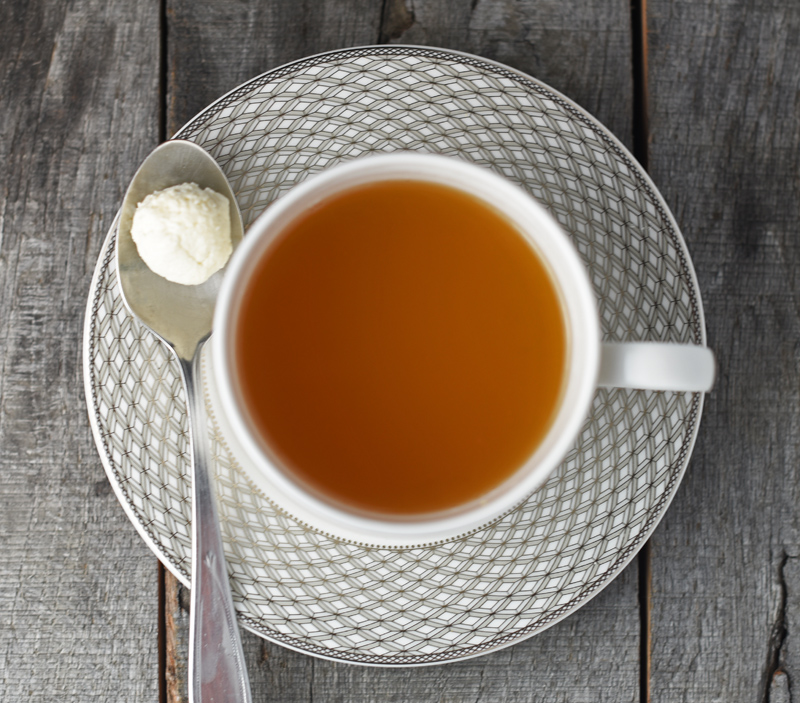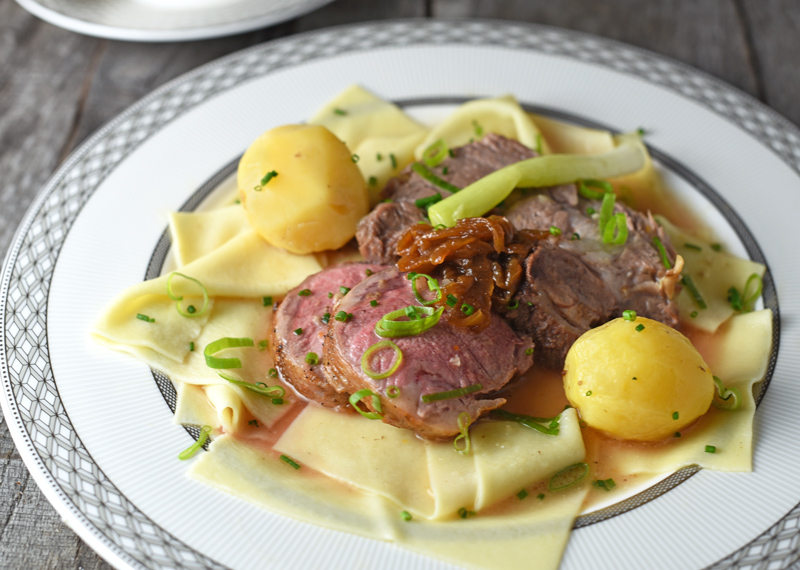Here’s a dish that fits with my current Central Asian travel story series and also helps me keep my New Year’s resolution: beshbarmak, Kazakhstan’s National Dish.
Kazakh cuisine borrows heavily from its neighbors, and doesn’t count many dishes it can genuinely call its own. This isn’t much of a surprise when you consider that one third of the land is occupied by the world’s largest dry steppe region, and the country has historically been inhabited by nomadic tribes. Beshbarmak is the most popular dish (another contender would be kuyrdak), though even it is shared with Kyrgyzstan, instead of being specifically Kazakh. The term beshbarmak means “five fingers” because the dish is traditionally eaten with one’s hands. However, I must say that I’ve never seen anybody eat it that way in the highly civilized restaurants of Almaty and Astana, and doing so must be terribly messy.
First things first, so what’s beshbarmak anyway? In essence, it’s boiled meat served atop large pieces of pasta. The meat can be one or more cuts of horse and/or lamb, though I’ve also seen veal and even fish in some Almaty restaurants. The pasta is usually cut into flat squares; I’ve seen a version in Astana where it was replaced with rice, though I can’t tell you if that was a regional variation or the restaurant’s invention. There will usually be some onion as well, possibly other vegetables from the Allium genus, like scallions, and sometimes boiled potatoes. On the side, you can expect a small bowl of meat broth, into which you can stir a spoonful of kurt (drained yogurt, see my qurutob recipe).
The larger the party, the more festive the cuts of meat — provided you consider a lamb’s head festive. Apparently, serving beshbarmak for a major event comes with a whole ritual that will bring solace to anti-progressive defenders of tradition and other worshipers of grandmothers’ recipes, as it is reminiscent of a more patriarchal time when people knew their place: elders first, then adult men (“the most respected guests”), then women (with special treatment on their wedding day), then children (with special encouragement for girls to work hard). Because, yes, the next time you flip nostalgically through a faded notebook filled with handwritten recipes, you should remember that this is what tradition is really about. From wikipedia:
Sheep’s head boiled in a kazan is put before the most honored guest, usually the eldest one. This person cuts the bits and parts from the head and offers them to the other guests at the table. The younger adults often receive the bones of the legs and shoulders. Boys are given the sheep’s ear with wishes to be careful; girls get the palate so as to be diligent. The other parts of the carcass are equally meaningful. The most respected guests are treated to gammon and shank. A young bride receives the brisket; however, married women are given the neck bones. Children are given the kidneys and heart, which are supposed to help them mature but not sheep’s brain, because it is believed to make them weak-willed. Knuckle is never served to a young girl, because of the belief that it will cause her to remain an old maid.
That being said, outside of Central Asia, you might very well need to get yourself invited to your friend John Doe’s Kazakh family dinner just to try beshbarmak if you don’t like to cook. I’m not aware of a single restaurant in New York that serves it — if you know one, please email me. Even in Moscow, Kazakh restaurants are few and far between compared to the ubiquitous Uzbeks (here’s one).
If you do like to cook, you’re in luck: it’s not hard to make at home… assuming you don’t try to acquire horse meat, a complicated affair in the United States (and ultimately a wild goose chase at the time of this writing). My version is festive in its own right, as I take some extra steps to make the dish more elegant. I am using the two best cuts of lamb: the pressure-cooked leg and the roasted rack. Then there are the caramelized onions, the scallions à l’étuvée, and the filtered broth. Still, you could keep things simple: make the pasta or buy lasagna sheets, cook your meat and vegetables in the pressure cooker, serve.
As for the festive lamb’s head, expect a follow-up post soon!
Lamb fabrication
Yields 6 servings
1 rack of lamb, about 500 g
transglutaminase (optional)
1 half leg of lamb (the thigh half, not the shank), bone in, about 1100 g
- Bone the rack of lamb, keeping the fat from the rib bones attached to the lean meat (called the noisette, btw). Fold the fat over the meat, tightly wrap into a log using several layers of plastic film, and refrigerate for at least 6 hours. If you have transglutaminase, you can sprinkle some onto the noisette before folding the fat over it. Reserve the bones for the lamb broth below.
- Bone the leg of lamb, then use string to tie into a roast, and refrigerate. Reserve the bones for the lamb broth below.
“Quick” kurt
Yields 6 servings
400 g plain whole milk yogurt
2 g salt
- Pour the yogurt into a 20 cm x 28 cm baking dish, and cook in a 150 C / 300 F oven for 1 1/2 hours, without disturbing it.
- Pass the yogurt through a chinois, gently pressing with a spatula to extract more whey. Discard the liquid. In a blender, mix the solids with the salt on low speed. At this point, if the solids have the texture of a paste and can be shaped into a ball, you’re done! Otherwise, return to the baking dish, spreading the mixture over half of the dish only, and cook for up to 30 minutes to reach the correct texture.
- Transfer the yogurt solids to a plastic container. Stir with a fork until homogeneous, and let cool.
Pasta squares
Yields 6 servings
230 g AP flour
2 g salt
120 g eggs
25 g egg yolks
15 g olive oil
- In the bowl of an electric mixer fit with the paddle attachment, place half of the flour, plus the salt, eggs, egg yolks, and olive oil. Mix on low speed until homogeneous, scraping down the sides with a spatula. Add the rest of the flour and mix again until you have a smooth paste.
- Transfer to a floured surface, and knead with your hands for about 3 minutes. You can add a little bit more flour if necessary, so that the dough doesn’t stick. Wrap in plastic and let rest for 30 minutes.
- Using a pasta machine, roll the dough to the thinnest setting. Cut into 6 cm squares, and transfer to a sheet tray lined with floured parchment paper. Sprinkle with flour, cover with plastic wrap, and reserve.

Caramelized onions
Yields 6 servings
15 g canola oil
20 g butter
375 g peeled onions, sliced
salt
black pepper, ground
110 g white wine
- In a saucepan over medium heat, combine the canola oil and butter. Add the onions, season with salt and pepper, and cook for about 15 minutes until brown, stirring regularly.
- Add half of the wine, and cook until fully reduced. Repeat with the other half of the wine. Reserve.
Pressure-cooked leg of lamb and lamb broth
Yields 6 servings
boned leg of lamb, tied into a roast, about 800 g
salt
black pepper, ground
20 g canola oil
lamb bones, about 500 g
250 g peeled onion, large dice
150 g peeled carrot, large dice
100 g celery, large dice
10 g peeled garlic, sliced
90 g white wine
900 g water
10 g flat-leaf parsley
450 g peeled assorted baby potatoes
- Season the lamb roast with salt and pepper. Sauté in canola oil in the pot of a pressure cooker until brown on all sides, and reserve.
- In the same pot, sauté the lamb bones, onion, carrot, celery, and garlic until brown. Season with salt, add the white wine, and simmer for a couple minutes. Return the lamb roast to the pot, and add the water and parsley. Cover the pressure cooker with its lid, bring to pressure, and cook for 30 minutes. Let cool for 15 minutes.
- Open the pressure cooker, add the potatoes, then close, bring back to pressure, and cook for another 15 minutes. Let cool for 5 minutes.
- Strain most of the broth through a chinois, keeping a few ladlefuls with the meat and potatoes in the closed pressure cooker. Discard the other vegetables and the lamb bones. If you want a perfectly clear broth, strain it one more time though a chinois lined with a coffee filter (warning: this may take some time). Reserve the lamb broth on one side, and the meat and potatoes in the pressure cooker on the other.
Roasted rack of lamb
Yields 6 servings
boned rack of lamb, about 300 g
salt
black pepper, ground
15 g canola oil
- Season the rack of lamb with salt and pepper. Sauté in the canola oil in a pan over high heat until brown on all sides.
- Transfer the pan to a 150 C / 300 F oven, and cook to the desired doneness (I recommend rare or medium-rare). Reserve.
Scallions à l’étuvée
Yields 6 servings
6 peeled scallion whites (about 45 g)
15 g butter
15 g water
salt
- In a saucepan over low heat, sauté the scallion whites (still whole) in the butter for a couple minutes. Add the water, season with salt, cover with a lid, and cook until tender.
- Reserve.
Assembly
Yields 6 servings
salt
pasta squares
40 g butter
pressure-cooked leg of lamb. potatoes and lamb broth
roasted rack of lamb
caramelized onions
scallions à l’étuvée
12 g scallion greens, thinly sliced
8 g chives, thinly sliced
“quick” kurt
- Bring a pot of salted water to a boil. Add the pasta, and cook until soft. Strain the pasta, and toss in a bowl with the butter and a couple ladlefuls of stock from the leg of lamb.
- Thinly slice the leg of lamb and rack of lamb.
- Divide the pasta between the plates. Top with slices of the two kinds of meats, and garnish with 2-3 potatoes and one scallion white each, plus some of the caramelized onions in the center. Pour the remaining stock from the leg of lamb over the plates, then sprinkle with scallion greens and chives. Serve.
- Pour the lamb broth into cups, and serve with spoonfuls of kurt on the side.





3 comments
Purists might beg to differ, but this looks better than any beshparmak I’ve ever had. The caramelized onions are a great touch!
Haha, thanks! Purists probably stopped reading my blog a long time ago.
We had this in an adobe hut when we stayed with Kazakhs in Bayan Olgi province, Western Mongolia. It was edible but not elegant & I don’t remember caramelized onions. We certainly ate with our 5 fingers.
I’m just back from Budapest where I found a Georgian restaurant, Hachapuri, along Andrassy Street (where we were staying).